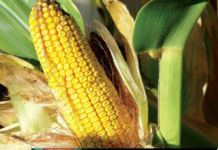By Ryan Flaming, County Extension Agent, Agriculture & Natural Resources
The sudden sharp drop in temperatures across Kansas this week will certainly cause the wheat crop to go into dormancy. Whether it will injure the wheat to any degree depends on several factors. The moisture level in the topsoil will be important. Soil moisture was generally good in most of the state going into October. But the warm temperatures in October caused some of the wheat in the state to put on excessive amounts of top growth, which dried out the soil. The cold temperatures will be more likely to cause injury to wheat if the plants were showing drought stress symptoms. Also, dry soils will get colder more easily than wet soils.
Last fall, there was a severe cold snap in early December that helped lead to winter injury on some wheat. But soils were generally both dry and fluffy last fall and winter, leaving the wheat somewhat exposed to damage. This year, even where soils have become a little dry they are generally much firmer than last year. This should help the wheat withstand cold temperatures a little better. Another important factor in wheat?s response to the cold is whether the wheat had time to become properly cold hardened. Although the weather was warm overall in October and early November, there may have been enough cold nights to have allowed the wheat to develop cold hardiness. The extent of the unusually large and rapid drop in temperatures from well above normal to well below normal is a concern. If the wheat did not develop sufficient cold hardiness, it would become more susceptible to injury from the recent cold snap. We likely won?t know for sure until next spring as the wheat comes out of dormancy.
The first thing we?ll be seeing is a lot of burndown of the wheat from these cold temperatures. If the wheat was bigger than normal, the plants may look ?rough? with a lot of brown dead-looking foliage on the soil surface. That doesn?t mean the plants are dead, however. The important factor will be whether the crown below the soil surface remains alive. Having a well-developed secondary root system will help the plants survive.




